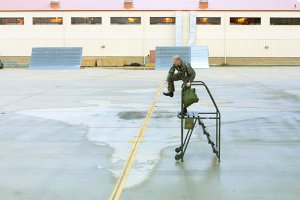Presented By: Aerospace Engineering
AE285 Undergraduate Seminar: Stealth…An Airplane Design Challenge
Grant Carichner, Adjunct Professor, Cal Poly Pomona

In any combat scenario it is advantageous to be invisible or nearly invisible to your adversary (recall Desert Storm/bombing of Baghdad in 1991). In any situation it is very important to limit your opponent’s ability to harm you. More than 50 years ago initial stealth efforts focused on incorporating materials into an airplane’s design to reduce radar signatures. This proved to be a difficult and elusive goal. Today ‘stealth’ is designed into virtually every military vehicle.
This seminar will review the history of early stealth efforts and conclude with where the state-of-the-art is today. Air vehicles will be the main focus but it will also become clear that stealth is being added to the designs of land and sea vehicles as well. In this discussion reducing the ‘signature’ of an air vehicle to radar will be the primary focus. However, it should be recognized that IR (infrared), audible, and visual signatures can also be very important. They will be introduced with little discussion.
Ultimately, the goal is to have a vehicle survive and be able to fly tomorrow’s missions or successfully penetrate enemy positions to destroy its target. Stealth is a major component of survivability but it is not the only one.
What was the first stealth airplane? You may be surprised to learn the answer.
About the Speaker
Mr. Carichner went to work for the Lockheed Skunk Works after earning his BS Engr and MS Engr degrees from UCLA. He retired in 2013 after 48 years at the Skunk Works where he worked on most of the company’s high-profile programs. During his career he started out as an aerodynamicist and eventually became Head of Aerodynamics for the Skunk Works. Future program assignments were either Chief Engineer or Program Manager positions. As Chief Engineer for the JASSM Program he was selected as Lockheed’s Inventor of the Year.
The last 15 years of his career were dedicated to lighter-than-air designs. He created the Aerocraft Program whose design resulted in a hybrid airship demonstrator that had many airplane flight characteristics that has changed the course of future airship design.
Currently, Mr. Carichner teaches Airplane Design at Cal Poly Pomona
Mr. Carichner has written two textbooks. One on airplane design and another on airship design. Both books are published by the AIAA:
Fundamentals of Aircraft and Airship Design: Volume I - Aircraft Design
Fundamentals of Aircraft and Airship Design: Volume II - Airship Design and Case
Studies
This seminar will review the history of early stealth efforts and conclude with where the state-of-the-art is today. Air vehicles will be the main focus but it will also become clear that stealth is being added to the designs of land and sea vehicles as well. In this discussion reducing the ‘signature’ of an air vehicle to radar will be the primary focus. However, it should be recognized that IR (infrared), audible, and visual signatures can also be very important. They will be introduced with little discussion.
Ultimately, the goal is to have a vehicle survive and be able to fly tomorrow’s missions or successfully penetrate enemy positions to destroy its target. Stealth is a major component of survivability but it is not the only one.
What was the first stealth airplane? You may be surprised to learn the answer.
About the Speaker
Mr. Carichner went to work for the Lockheed Skunk Works after earning his BS Engr and MS Engr degrees from UCLA. He retired in 2013 after 48 years at the Skunk Works where he worked on most of the company’s high-profile programs. During his career he started out as an aerodynamicist and eventually became Head of Aerodynamics for the Skunk Works. Future program assignments were either Chief Engineer or Program Manager positions. As Chief Engineer for the JASSM Program he was selected as Lockheed’s Inventor of the Year.
The last 15 years of his career were dedicated to lighter-than-air designs. He created the Aerocraft Program whose design resulted in a hybrid airship demonstrator that had many airplane flight characteristics that has changed the course of future airship design.
Currently, Mr. Carichner teaches Airplane Design at Cal Poly Pomona
Mr. Carichner has written two textbooks. One on airplane design and another on airship design. Both books are published by the AIAA:
Fundamentals of Aircraft and Airship Design: Volume I - Aircraft Design
Fundamentals of Aircraft and Airship Design: Volume II - Airship Design and Case
Studies